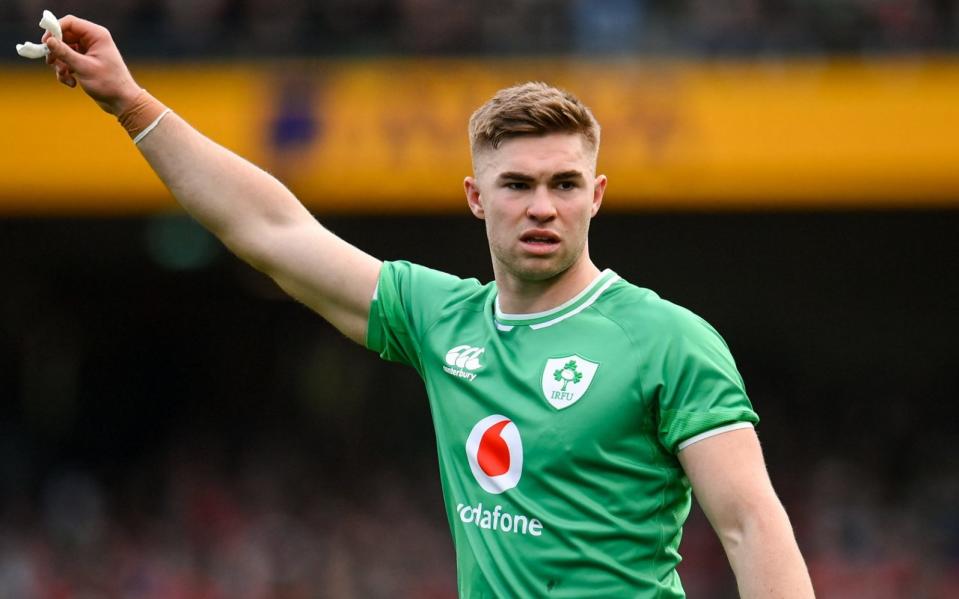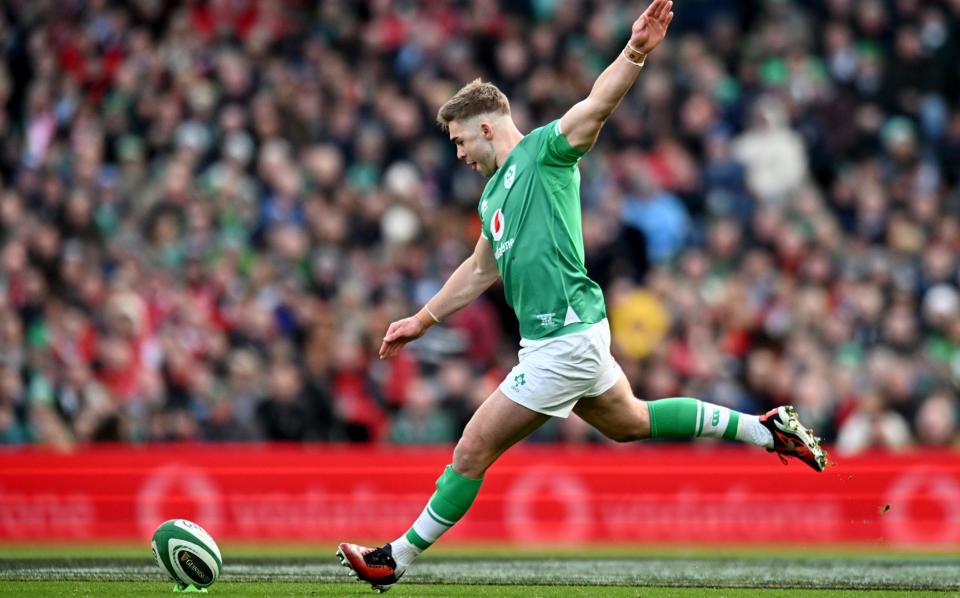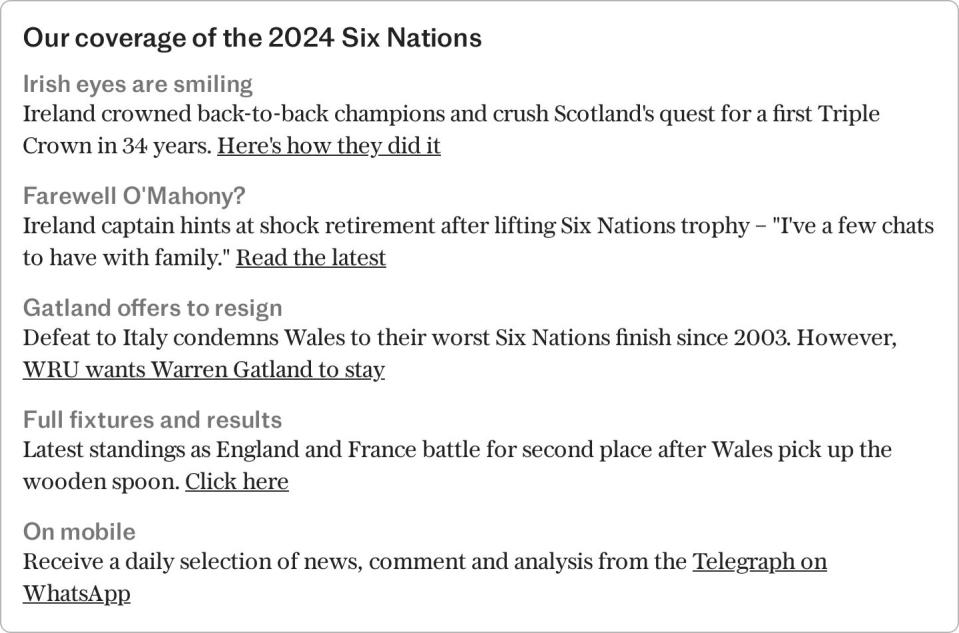In the footsteps of Jack Crowley – where inspirational Ireland No 10’s story began

On every Saturday at Bandon Rugby Football Club, about 20 miles west of Cork, around 360 children are in attendance playing across multiple age groups helped out by close to 80 volunteers. The under-eights side recently added a new tradition to the end of their training sessions: the Jack Crowley kicking competition.
To say that Ireland’s new fly-half has deep roots with Bandon would be selling it short. Crowley’s father, Fachtna, played for the club, as did his uncles Liam, Gerard and Declan, and his brothers, Jerry and Billy. At this point you probably think that seems like quite a lot of family members but we have not spoken about the Burkes yet on Crowley’s mother’s side, with uncles Eoin and another Liam playing for the club while Tadhg coaches.
What about cousins, I hear you ask, bewilderingly, as if that was not enough relatives already.
“If you get into cousins, you would run out of toes and fingers very quickly,” Dan Murphy, Bandon’s club president, tells Telegraph Sport. Matty, Emily, Cathal and Ian are four who have played for Bandon. “There would be cousins all over the place,” he adds. I believe him.
Founded in 1882, Bandon is one of the oldest clubs in Ireland, based in a rural town drawing from around seven or eight surrounding parishes. In that long history, Bandon had previously produced one Ireland international: Henry Wall, a No 8 who won two caps in 1965. Now they have Crowley.
Hearing of the delight that the 24-year-old’s ascent has brought to the club, you can appreciate the tightness of a community that has helped to develop Crowley since he joined at under-nines, playing through to under-18s when he was a key part of Bandon’s all-Ireland Under-18 youth competition triumph.
When Crowley was 12, Munster players came to the club to present medals to the youngsters at the end-of-season barbecue. Peter O’Mahony was one of them. Twelve years later, the duo are team-mates with both Munster and Ireland.
Incredible photo here, as 12-year-old Jack Crowley met @Munsterrugby stars - his future team-mates - Peter O'Mahony & @SimonZebo at @bandonrfc end-of-season awards in 2012. Now look where Jack is, heading to World Cup alongside O'Mahony.
📸 Thanks to Damien Healy of Bandon RFC pic.twitter.com/MXu1fx3vjf— Kieran McCarthy (@KieranMcC_SS) August 30, 2023
Last year, it was Crowley who returned to Bandon to present medals to the club’s starstruck young players. “It was gas to see it come around full circle. It probably took 45 minutes to get him out of the car park with the kids hanging off him,” Murphy says with a laugh.
“He is good for the club. I think Jack is very proud of his roots. Anything you ask him to do with the club, he does with a heart and a half. We had a fundraising event recently and he contributed a signed set of boots. To have a guy who can go all the way, for people to see him and go, ‘Jesus, that’s our Jack Crowley’, there is massive pride in the club.”
Listening to Murphy, the following traits were obvious in Crowley from a young age. Exceptional talent, obviously, with Crowley switching between scrum-half and fly-half at youth level. Composure under pressure. “I think any class No 10 has to have that to survive,” Murphy says. And finally sheer force of will to succeed, to learn, to improve.
It felt like Ireland were searching forever for a long-term successor to Johnny Sexton, handing out caps to Joey Carbery, Billy Burns, Jack Carty among others now all off the radar. Since Crowley’s debut against Fiji about 18 months ago, the answer seemed obvious.
Perhaps there is no higher compliment for Crowley than the following nugget of gold from Mike Prendergast, Munster’s attack coach and former scrum-half. Prendergast is close with Ronan O’Gara, still the king of Munster fly-halves and the outstanding predecessor to Sexton. O’Gara, who in recent years has coached La Rochelle to successive Champions Cup titles, disclosed to Prendergast that he had tried to bring Crowley to La Rochelle. When Prendergast left Racing 92 to join Munster’s coaching staff, he quickly saw why O’Gara had been interested.
“He just doesn’t get flustered,” Prendergast tells Telegraph Sport. “Because he is a young 10, so much goes through him and there are going to be a couple of mistakes. But he has this ability, this ‘next job’ mentality. Whether it’s good, bad or indifferent, he just goes on to his next job. He is a great lad, brilliant to work with. So diligent. A very deep thinker of the game, and I believe he has been like that from a young age.”
Crowley will regularly send texts to Prendergast either after training or watching games. “He’s an incredibly driven young man.”

Perhaps one reason why Crowley has looked so settled in this Six Nations is that Ireland and Munster operate with similar attacking systems – wingers coming off the edges, starting from a framework before “expressing yourself within that”, as Prendergast puts it. Not to mention the luxury of playing behind a relentless pack and with the steady heads of Jamison Gibson-Park (or Conor Murray), Bundee Aki, Robbie Henshaw (or Garry Ringrose) around you.
But focusing on those helpful extras arguably does Crowley a disservice. Last season, Munster had three strong fly-halves in Crowley, Carbery and Ben Healy (now with Edinburgh and Scotland), with Prendergast keen to get as many ball players on the field as possible. Which meant that, along with Crowley’s previous experience at scrum-half, he had six starts last season at inside centre, including in the United Rugby Championship semi-final win over Leinster, and one at full-back.
“I remember Dan Carter in the younger stages of his career doing something similar,” Prendergast notes. Carter started his first 11 Tests at inside centre outside Carlos Spencer. “There’s a cliché about it giving them a good feel for the game, but I really believe it does. It has broadened his game a bit.”
Munster went on to win the URC title, their first trophy for 12 years. Crowley started the final at No 10.
His defence is “very good”, his kicking game “growing”, but there is a clear super strength, as Prendergast explains. “When he is up on the line, having those options and threats, then executing. He is able to stick defenders, to either go front door or back door [with his pass]. We saw that with Tadhg Beirne’s try against France, that no-look front-door pass. Staying really square.
“Because he’s physical, he is brave and tough and doesn’t mind getting hit, a bit like Jonny Wilkinson and Sexton in a way. You saw those guys take punishment over the years. We call it being a good team player, taking it to the line and creating space for others. That is probably Jack’s biggest strength at the moment. The way Ireland are playing, the amount that goes through him, he’s been very impressive. But it doesn’t surprise me.”

Comparisons to the likes of O’Gara and Sexton are inevitable but both Murphy and Prendergast share the same opinion; that Crowley is no replica and “very much his own man”.
No one will be more eagerly watching how Ireland’s No 10 gets on at Twickenham than the masses back at Bandon. The Crowleys and the Burkes, of course, but the whole club seem to really be one big family, proudly cheering on their most famous son.


 Yahoo Sport
Yahoo Sport 





































